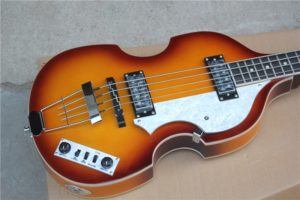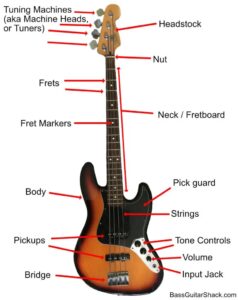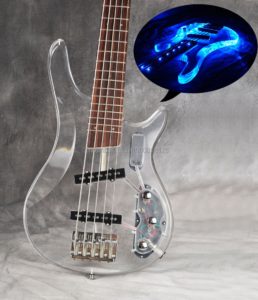Mastering the Basics: A Beginner’s Guide to Bass Guitar
Listen to the Audio: A Beginner’s Guide to Bass Guitar”

Are you a music enthusiast looking to embark on a new musical journey? Look no further than the bass guitar! The bass guitar is an essential instrument that forms the backbone of any band or ensemble. Whether you’re a complete beginner or a guitarist looking to expand your skills, mastering the basics of bass guitar is a fantastic way to enhance your musical abilities.
In this comprehensive beginner’s guide, we will explore everything you need to know to get started on your bass guitar journey. From understanding the anatomy of the instrument to learning essential techniques like plucking and fretting, we will break down each concept step-by-step. With our expert tips and guidance, you’ll be strumming those bass strings with confidence in no time.
So, grab your bass guitar, tune it up, and let’s dive into the world of mastering the basics of bass guitar!
Understanding the Role of the Bass in a Band
The bass guitar is often referred to as the “heartbeat” or the “glue” of a band. It provides the foundation and rhythm for the entire musical ensemble. While the lead guitar and vocals may take the spotlight, the bass guitar keeps everything grounded and in sync. The bassist’s main role is to provide a solid and consistent groove, ensuring that the band stays tight and maintains a steady rhythm.
To fulfil this role effectively, it’s crucial for bass players to understand rhythm and timing. This means developing a strong sense of timing and being able to lock in with the drummer’s beats. Additionally, bassists must have a good ear for harmony and be able to complement the chords and melodies played by the other instruments.
By mastering these skills, bass players can create a powerful and cohesive sound that elevates the entire band’s performance.
Parts of a Bass Guitar

Before diving into playing techniques, it’s essential to familiarize yourself with the different parts of a bass guitar. Understanding the anatomy of the instrument will not only help you communicate with other musicians but also enable you to make informed decisions when it comes to choosing and maintaining your bass.
The main components of a bass guitar include the body, neck, fretboard, headstock, tuning pegs, pickups, bridge, and strings.
- Body
The body of a bass guitar plays a significant role in its sound. Different types of wood are used for bass guitar bodies, each with its own tonal characteristics. For example, ash is known for its bright and punchy sound, while mahogany offers a warmer and more resonant tone. Consider the tonal qualities you prefer and choose a bass guitar with a body wood that aligns with your desired sound.
- Neck
The neck of a bass guitar affects its playability and feel. Bass guitar necks are typically made of maple, mahogany, or a combination of both. Maple necks are known for their bright and snappy tone, while mahogany necks offer a warmer and more rounded sound. Consider the neck profile and shape that feels comfortable in your hands. Slim necks are often preferred by those with smaller hands, while chunkier necks provide more stability and support for players with larger hands.
- Pickups
Pickups are responsible for converting the vibrations of the strings into electrical signals, which are then amplified and heard through the speakers. There are two main types of pickups used in bass guitars: single-coil and humbucker pickups. Single-coil pickups offer a clear and bright sound, while humbucker pickups provide a thicker and more powerful tone.
Consider the music genres you’ll be playing and the tone you want to achieve. If you’re into rock or metal, a bass guitar with humbucker pickups may be more suitable. If you’re into jazz or funk, you might prefer a bass guitar with single-coil pickups for a brighter and more articulate sound.
- Bridge
The bridge of a bass guitar affects the sustain, intonation, and overall feel of the instrument. There are different types of bass guitar bridges, including the standard bridge, vintage-style bridge, and the modern bridge. Each type has its own advantages and considerations. The standard bridge is the most common and offers a balance of sustain and adjustability. Vintage-style bridges are known for their vintage aesthetics and slightly warmer tone. Modern bridges provide improved sustain and intonation.
Consider your playing style and preferences when choosing a bass guitar bridge. If you’re a beginner, a standard bridge will likely suffice, as it offers a good balance of functionality and ease of use.
Types of Bass Guitars
 Just like guitars, bass guitars come in various types, each with its own unique characteristics and sound. The most common types of bass guitars are the electric bass and the acoustic bass.
Just like guitars, bass guitars come in various types, each with its own unique characteristics and sound. The most common types of bass guitars are the electric bass and the acoustic bass.
Electric bass guitars are the most popular choice among bass players. They produce a powerful and punchy sound, making them ideal for rock, pop, and funk genres. Electric bass guitars are typically solid body instruments, which means they don’t have a hollow chamber like acoustic basses. They require an amplifier to be heard properly and can be played with fingers or a pick.
Acoustic bass guitars, on the other hand, have a hollow body similar to acoustic guitars. They produce a warmer and more resonant sound, making them suitable for genres like folk, jazz, and unplugged performances. Acoustic bass guitars can be played without an amplifier, making them a convenient option for small gatherings or intimate settings.
Factors to consider when choosing a beginner bass guitar
Now that you have a basic understanding of the different types of bass guitars, let’s dive into the factors you should consider when choosing a beginner instrument. These factors will help you narrow down your options and find a bass guitar that suits your needs and playing style.
- Budget
Setting a budget is an essential first step when choosing a beginner bass guitar. Prices can vary significantly, ranging from budget-friendly options to high-end models. It’s important to determine how much you’re willing to invest in your instrument. Keep in mind that while higher-priced bass guitars often offer better quality and craftsmanship, there are also affordable options that provide excellent value for money.
- Sound and Tone
The sound and tone of a bass guitar are determined by various factors, including the type of wood used in the construction, the pickups, and the electronics. Different types of wood, such as maple, mahogany, and ash, produce distinct tones. Additionally, the type of pickups, such as single-coil or humbucker pickups, can greatly influence the sound of the bass guitar.
Consider the music genres you’ll be playing and the tone you want to achieve. For example, if you’re into rock or metal, a bass guitar with humbucker pickups and a solid body may be more suitable. If you’re into jazz or funk, you might prefer a bass guitar with single-coil pickups and a semi-hollow body for a warmer tone.
- Playability and Comfort
The playability and comfort of a bass guitar are crucial factors, especially for beginners. Look for a bass guitar with a comfortable neck profile and a smooth fretboard. The neck profile refers to the shape and thickness of the neck, which can vary from slim to chunky. Choose a neck profile that feels comfortable and natural in your hands.
Additionally, consider the weight of the bass guitar. Heavy bass guitars can cause strain and discomfort during long practice sessions or performances. Try different bass guitars to find the one that feels comfortable and allows you to play for extended periods without any discomfort.
Choosing the Right Bass Guitar for You
Now that you’re familiar with the different types of bass guitars, it’s time to choose the right one for you. When selecting a bass guitar, consider factors such as your budget, playing style, musical genre, and personal preferences.
If you’re a beginner, it’s recommended to start with a budget-friendly bass guitar that offers good quality and playability. Look for brands that are known for their beginner-friendly instruments, as they often provide excellent value for money. As you progress and develop your skills, you can consider upgrading to a higher-end bass guitar that suits your evolving needs and preferences.
When trying out different bass guitars, pay attention to the feel and comfort of the instrument. A well-balanced bass with a comfortable neck and appropriate string spacing will make it easier for you to play for extended periods without fatigue. Additionally, listen to the sound produced by the bass guitar and determine if it matches your desired tone and style.
Remember, the best bass guitar for you is the one that feels comfortable in your hands and inspires you to play. So, take your time, try out different options, and choose the bass guitar that resonates with you both physically and musically.
Essential Bass Guitar Techniques
Now that you have your bass guitar in hand, it’s time to dive into some essential techniques that will set you on the path to becoming a proficient bass player. These techniques form the foundation of your playing and are crucial for creating a solid groove and rhythm.
Plucking Technique
The most common plucking technique used by bass players is called “fingerstyle.” This technique involves using your fingers (usually the index and middle fingers) to pluck the strings. To execute the fingerstyle technique, rest your thumb on the pickup or the E string for stability, and use your index and middle fingers to alternate between plucking the strings. Start by plucking the strings near the bridge for a brighter and punchier sound, and gradually experiment with different plucking positions to explore different tones.
Slap and Pop
Another popular plucking technique is “slap and pop.” This technique involves slapping the strings with your thumb and popping them with your fingers. Slapping creates a percussive sound, while popping produces a sharp and snappy tone. Slap and pop techniques are commonly used in funk, rock, and slap bass playing styles.
Fretting Technique
Fretting refers to pressing down on the strings against the frets to produce different notes. To execute the fretting technique correctly, place your fingertips just behind the fret wire, ensuring that you’re pressing down firmly enough to produce a clear and clean sound. Avoid pressing too hard, as it can cause the notes to sound sharp or out of tune. Practice fretting with all four fingers of your fretting hand, gradually building strength and dexterity in each finger.
Basic Scales and Exercises for Beginners
Learning scales is essential for developing your bass playing skills and improvisation abilities. The most common scale used in bass playing is the Major Scale. This scale consists of seven notes and serves as the foundation for many other scales and musical concepts. Practice playing the Major Scale in different keys, starting from the root note and ascending and descending the scale.
In addition to scales, there are several exercises that can help improve your finger dexterity, timing, and coordination. One popular exercise is the chromatic exercise, which involves playing each fret on each string in ascending and descending order.
Another exercise is the finger stretching exercise, where you stretch your fingers across multiple frets to build strength and flexibility.
Popular Bass Guitar Songs for Beginners
Playing songs is a great way to apply the techniques and concepts you’ve learned on the bass guitar. Here are a few popular bass guitar songs that are beginner-friendly and fun to play:
- “Stand by Me” by Ben E. King
- “Seven Nation Army” by The White Stripes
- “Another One Bites the Dust” by Queen
- “Come Together” by The Beatles
- “Smoke on the Water” by Deep Purple
These songs feature simple yet catchy bass lines that will help you develop your groove and timing. Start by learning the basic bass lines and gradually add variations and embellishments as you become more comfortable.
Tips for Practicing and Improving Your Bass Playing
Consistent and focused practice is key to mastering any instrument, including the bass guitar. Here are some tips to help you make the most out of your practice sessions:
- Establish a regular practice schedule: Set aside dedicated time each day or week to practice. Consistency is more important than the duration of each practice session.
- Break down your practice sessions: Divide your practice time into different sections, focusing on specific techniques, scales, or songs. This will help you stay organized and make progress in each area.
- Start slow and gradually increase speed: When learning a new technique or song, start at a comfortable tempo and gradually increase the speed as you become more comfortable. This will help you build accuracy and muscle memory.
- Use a metronome: Practice with a metronome to develop a strong sense of timing and rhythm. Start at a slow tempo and gradually increase the speed as you improve.
- Record and listen to yourself: Recording your practice sessions and listening back will help you identify areas for improvement and track your progress over time.
- Play with others: Jamming with other musicians, whether in a band setting or informal jam sessions, will help you develop your ability to play in sync with others and adapt to different musical styles.
Remember, progress takes time and patience. Be kind to yourself and celebrate the small victories along the way.
Maintenance and care for your beginner bass guitar
Once you’ve chosen your beginner bass guitar, it’s important to take proper care of it to ensure its longevity and optimal performance. Here are some maintenance tips:
- Cleaning
Regularly clean your bass guitar to remove dirt, sweat, and grime that can accumulate over time. Use a soft, lint-free cloth to wipe the body, neck, and strings after each playing session. Avoid using harsh chemicals or abrasive materials that can damage the finish.
- String care
Replace your bass guitar strings regularly to maintain optimal tone and playability. Strings can lose their brightness and become dull over time. Set a schedule for changing your strings based on your playing frequency and style.
- Humidity control
Bass guitars are susceptible to changes in humidity, which can cause the wood to swell or shrink. Use a humidifier or dehumidifier to maintain a stable humidity level in your practice space. Avoid exposing your bass guitar to extreme temperature or humidity conditions.
- Storage
When not in use, store your bass guitar in a suitable case or gig bag to protect it from dust, moisture, and accidental damage. Keep it in a cool and dry environment, away from direct sunlight or excessive heat.
- Regular maintenance
Periodically inspect your bass guitar for any signs of wear or damage. Check the frets, tuners, and electronics for any issues. If you’re unsure about performing maintenance or repairs, consult a professional guitar technician.
By following these maintenance tips, you’ll have a lot of time and fun from your bass guitar.
Resources for Further Learning and Development
Learning the bass guitar is an ongoing journey, and there are plenty of resources available to help you continue your growth as a bass player. Here are a few recommended resources:
- Online bass tutorials and lessons: There are numerous websites and YouTube channels dedicated to bass guitar tutorials and lessons. Some popular ones include Scott’s Bass Lessons, TalkingBass, and BassBuzz.
- Bass books and instructional materials: Books such as “Hal Leonard Bass Method” by Ed Friedland and “Bass Guitar for Dummies” by Patrick Pfeiffer provide comprehensive guides for beginners.
- Bass forums and communities: Joining online bass forums and communities can connect you with fellow bass players, allowing you to share tips, ask questions, and learn from experienced players.
- Private lessons: Consider taking private lessons with a professional bass teacher who can provide personalized guidance and feedback tailored to your specific needs and goals.
- Local music schools and workshops: Check out your local music schools and community centres for bass workshops and classes.
Remember, learning the bass guitar is a continuous process, and there’s always something new to discover. Embrace the journey and enjoy the process of mastering this incredible instrument.
Conclusion to the Beginner’s Guide to Bass Guitar

Congratulations on taking the first step towards mastering the basics of bass guitar! In this beginner’s guide, we explored the essential concepts, techniques, and resources that will set you on the path to becoming a proficient bass player.
Remember, learning any instrument requires time, dedication, and patience. Embrace the challenges, enjoy the process, and never stop exploring the possibilities of the bass guitar. With practice and determination, you’ll soon be strumming those bass strings with confidence and creating your own unique grooves. So, grab your bass guitar, tune it up, and let the music begin!
Download the Free eBook – A Beginners Guide to Bass Guitar
